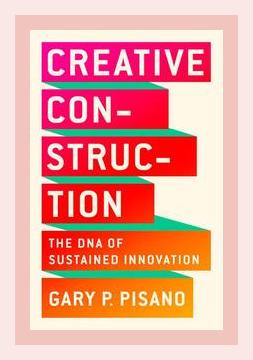Innovation and CreativityDisruptive Innovation
Creative Construction: A 5-Page Summary
Creative Construction: The DNA of Sustained Innovation by Gary P. Pisano, published in 2019, explores how established organizations can innovate effectively and consistently. Drawing from his extensive experience and a wide array of case studies, Pisano challenges the entrenched belief that innovation is solely the domain of startups and small entrepreneurial ventures. Instead, he presents a detailed blueprint for how larger, more mature organizations can cultivate and sustain innovation.
Introduction: The Complexity of Innovation
Major Point: Pisano opens with the assertion that large, established companies can be just as innovative as startups, but the process requires a different approach.
Action: Embrace complexity in innovation strategies rather than expecting simple solutions or silver bullets.
Chapter 1: Debunking Myths About Innovation
Major Point: Pisano debunks common myths that hold back organizations from becoming innovative, such as the belief that innovation mainly comes from maverick geniuses or that big companies can’t innovate.
Example: He highlights how IBM, once seen as a dinosaur, has consistently reinvented itself over decades, venturing into new areas like AI and cloud computing through structured innovation practices.
Action: Leaders should actively challenge and dispel these myths within their organizations, fostering a culture that believes in the capacity for innovation.
Chapter 2: The Innovation Strategy
Major Point: Successful innovation is underpinned by a clear and coherent strategy that aligns with the overall goals of the organization.
Example: Pisano points to Amazon’s strategy, which emphasizes a relentless focus on customer experience and extensive use of data to drive decisions, enabling it to venture into diverse sectors successfully.
Action: Develop a strategic innovation framework that aligns with the company’s vision and core strengths.
Chapter 3: Structuring for Innovation
Major Point: Organizational structures need to be designed to support continuous innovation. Proper structuring involves striking a balance between stability and flexibility.
Example: Google’s model, where small teams operate with high autonomy while being aligned with the company’s broader objectives, fosters both creativity and efficiency.
Action: Implement agile organizational structures that allow for cross-functional teams and fluid movement of talent.
Chapter 4: Building an Innovation Culture
Major Point: Culture plays a pivotal role in innovation. A culture that encourages risk-taking, learning from failure, and intrinsic motivation is essential.
Example: Pixar’s culture is highlighted for its open communication and constructive feedback loops, which are crucial for its creative success.
Action: Cultivate a culture that celebrates calculated risks and learns from failures rather than punishing them.
Chapter 5: Managing Innovation Platforms
Major Point: Successful innovation often involves creating platforms that can be leveraged to develop multiple products or services.
Example: Apple’s iOS platform is discussed as a prime example of how a robust platform can spawn a vast ecosystem of applications, driving continuous innovation and customer engagement.
Action: Invest in developing scalable innovation platforms that can be the foundation for future growth.
Chapter 6: Balancing Open and Closed Innovation
Major Point: Organizations must balance the benefits of open innovation (collaborating with external partners) with the need to protect proprietary knowledge (closed innovation).
Example: Procter & Gamble’s Connect + Develop program leveraged external partnerships to drive innovation while integrating these into their internal R&D efforts.
Action: Develop a flexible approach that leverages external partnerships while safeguarding core intellectual property.
Chapter 7: Scaling Innovations
Major Point: Scaling innovations from idea to full-scale deployment requires meticulous planning and execution.
Example: Toyota’s adoption of lean manufacturing principles from a small experiment to a global strategy exemplifies successful scaling.
Action: Develop a clear roadmap for scaling innovations, including pilot testing, iterative refinement, and phased implementation.
Chapter 8: The Leadership Role
Major Point: Leadership is crucial in driving and sustaining innovation. Leaders need to be both visionary and pragmatic, facilitating an environment where innovation can flourish.
Example: Satya Nadella’s leadership at Microsoft, which involved shifting the company’s focus towards cloud computing and AI, reinvigorated its innovation potential.
Action: Leaders should foster a vision that encourages innovation, provide the resources needed, and actively remove barriers that impede innovation.
Chapter 9: Metrics and Incentives
Major Point: Proper metrics and incentives are necessary to track progress and motivate employees toward innovation.
Example: 3M’s practice of allowing employees to spend 15% of their time on projects of their choosing is a powerful incentive that fosters innovation and creativity.
Action: Establish metrics and incentives that align with and promote the innovation objectives of the organization.
Conclusion: The Path Forward
Major Point: In conclusion, Pisano emphasizes that sustainable innovation is an ongoing journey, requiring commitment, strategic alignment, and adaptive capabilities.
Action: Commit to a long-term innovation strategy that continuously evolves with the changing market dynamics and organizational growth.
In synthesizing Pisano’s comprehensive guide on innovation, several key actionable insights emerge for individuals and organizations seeking to enhance their innovative capacities. From cultivating an open, risk-tolerant culture to implementing agile structures, each strategy is grounded in real-world examples and practical insights. By adopting these practices, established companies can successfully navigate the complexities of innovation, turning potential disruption into sustained growth and competitive advantage.
